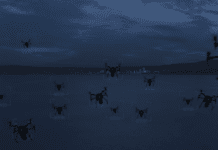This post is also available in:
 עברית (Hebrew)
עברית (Hebrew)
Swarming capability involves one or two pilots getting a flock of drones airborne to act autonomously as a team to carry out a mission. It’s a feat that requires a highly-skilled, multifaceted team of engineers and scientists.
A team of US Naval Information Warfare Center (NIWC) engineers has been advancing unmanned aerial vehicle technology through their work on autonomous drone swarms for nearly a decade. Their Small Autonomous Unmanned Systems Research (SAUSR) Range team demonstrated their newest swarming capabilities during the Advanced Naval Technology Exercise (ANTX) this summer.
“We’re on the forefront of developing these technologies for the Navy and Marine Corps,” said unmanned aerial systems expert and SAUSR Range team lead Brad Knaus. “We can see from these exercises what the Navy needs when it comes to developing that technology. It gives us a sense of fulfillment that what we’re doing directly affects them,” he added.
The team briefed ANTX East assessors on some of the newest swarming features such as tablet consolidation, payload delivery, drone decoys and Sensor Platform to Identify Expeditionary Cyber Signals Environments for Exploitation (a.k.a. SPIDER SENSE) integration.
According to dvidshub.net, the integration of a plugin for an Android Tactical Assault Kit, a tablet-based program, is the most recent advancement in drone swarming control. The team also consolidated ground control station hardware to fit into a hard case by using some collapsible parts. That means less equipment and greater mobility — and therefore fewer warfighters — per swarm in theater.
The swarm technology now works in tandem with SPIDER SENSE, a low-cost, battery-powered, ad hoc wireless network of small form factor, modular, mission-specific sensors for fusion of expeditionary cyber, radio frequency (RF) and physical situational awareness. Because of this integration, UASs can be used to deploy SPIDER SENSE sensor packages in the field.
The demonstration at ANTX East was an opportunity to gain feedback from over 100 assessors and to brief Navy officials on the latest warfighting technology.
Future development involves current efforts in using drones as decoys and the eventual transfer of swarming technology into other domains. The next trend is multi-domain swarming, or transferring drone swarm technology to other types of vehicles like unmanned ground vehicles (UGVs). The use of swarms of both UGVs and UAVs to thwart adversary threats could help warfighters take advantage of new offensive tactics. Having fewer people in theater demonstrating more power than previously required minimizes human risk and helps create a safer, more efficient Navy for warfighters.

























